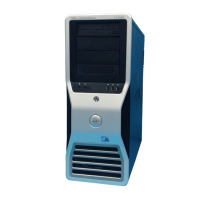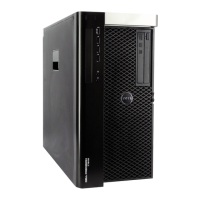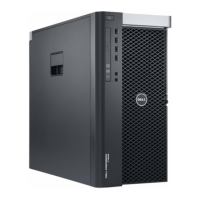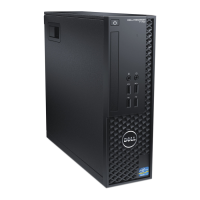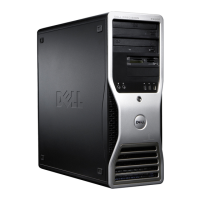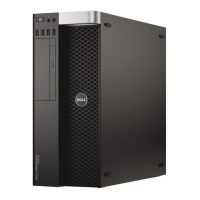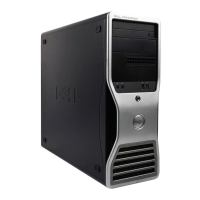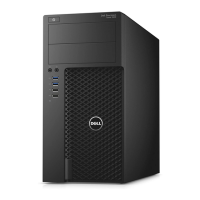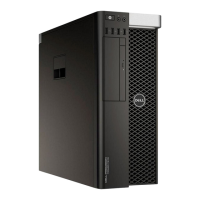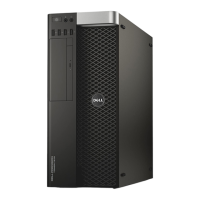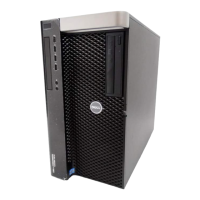Do you have a question about the Dell Precision T7400 and is the answer not in the manual?
Defines the meaning of NOTE, NOTICE, and CAUTION indicators used in the document.
Guides on finding diagnostic programs, drivers, documentation, and software.
Details about the Drivers and Utilities disc and software update sources.
Instructions for accessing the Dell Precision ™ User's Guide via Windows Help.
Information on warranty, safety, regulatory, and license agreements.
How to find the Service Tag and Windows Product Key on the computer.
Using support.dell.com for solutions, community, upgrades, and downloads.
Instructions for downloading and installing DSS for system operation.
Steps to navigate and utilize the Windows Help and Support Center.
Information on using the OS disc for reinstallation and driver recovery.
Procedures and safety notes for switching between tower and desktop orientations.
Specific steps to reconfigure the computer from tower to desktop orientation.
Specific steps to reconfigure the computer from desktop to tower orientation.
Guidelines for installing the computer in an enclosure, focusing on ventilation.
Specifies minimum clearance for proper airflow around the computer.
Visual examples illustrating correct and incorrect enclosure installations.
Using the Files and Settings Transfer Wizard for data migration in Windows XP.
Explains the necessity of the OS disc for the data transfer wizard functionality.
Detailed steps for using the wizard with the OS disc to transfer files.
Procedure for copying data from the old computer during the transfer process.
Steps to create and use a wizard disk for data transfer without the OS disc.
Instructions for creating a wizard disk for file transfer purposes.
Using Windows Easy Transfer for data migration in Windows Vista.
Introduction to surge protectors, line conditioners, and UPS systems.
Explanation of surge protectors and how to choose them based on joule ratings.
Description of line conditioners for maintaining stable AC voltage.
Information on UPS devices, their battery function, and UL approval.
Diagram and labels identifying components on the computer's front panel.
Diagram and labels identifying components on the computer's back panel.
Description of power connector, card slots, and general back panel connectors.
Details on connecting parallel, PS/2 mouse, and IEEE 1394 devices.
Explanation of line-in and line-out connectors for audio devices.
Details on network, USB, keyboard, and serial connectors.
Safety precautions and methods for cleaning the computer, keyboard, and monitor.
Step-by-step instructions for cleaning a non-optical mouse.
Notices on cleaning floppy drives and discs (CDs/DVDs).
Explains the meaning of different power light states for troubleshooting.
Detailed troubleshooting for power light conditions (off, blinking amber, steady amber).
Overview of the four diagnostic lights on the front panel for troubleshooting.
Table of light patterns and their suggested resolutions during POST.
Explanation of beep codes emitted during startup for diagnostics and remedies.
Troubleshooting steps for diskette read failures and boot device availability.
Steps to use the Hardware Troubleshooter in Windows XP and Vista.
Procedure to initiate Dell Diagnostics from the internal hard drive partition.
Steps to initiate Dell Diagnostics from the bootable Drivers and Utilities disc.
Overview of tests available in the Dell Diagnostics Main Menu.
Description of the Express Test for a quick system check.
Details on Extended, Custom, and Symptom Tree tests for diagnostics.
Steps for troubleshooting and replacing the computer battery.
Ensuring Windows recognizes drives and troubleshooting drive issues.
Specific troubleshooting steps for optical drive issues like vibration and disc reading.
Procedure for running Check Disk to scan and recover hard drive errors.
Steps to troubleshoot e-mail, modem connectivity, and internet access.
Guidance on checking Outlook Express security for email attachments.
How to run modem diagnostic tools in Windows XP and Vista.
Steps to confirm the modem is communicating correctly with Windows.
General guidance on error messages and filename restrictions.
Steps to fix errors caused by missing .DLL files by reinstalling programs.
Troubleshooting steps for problems related to IEEE 1394 devices.
Steps for troubleshooting keyboard connection and functionality.
Initial troubleshooting steps for when the computer does not start up.
Steps for handling unresponsive computers and programs.
Guidance on troubleshooting programs that crash frequently.
Troubleshooting steps for insufficient memory and other memory-related issues.
Steps for troubleshooting mouse connectivity, settings, and drivers.
Steps for troubleshooting network connectivity and settings.
Troubleshooting for power light status and related issues.
Troubleshooting steps for printer setup, connection, and recognition.
Troubleshooting steps for scanner setup, connection, and recognition.
Troubleshooting steps for issues with speaker audio output.
Troubleshooting steps for issues with headphone audio output.
Steps to troubleshoot when the monitor screen is blank.
Troubleshooting steps for monitor display quality issues like blurriness or distortion.
Adjusting display settings and troubleshooting poor 3D graphics quality.
Defines the meaning of NOTE, NOTICE, and CAUTION indicators used in the document.
Guides on finding diagnostic programs, drivers, documentation, and software.
Details about the Drivers and Utilities disc and software update sources.
Instructions for accessing the Dell Precision ™ User's Guide via Windows Help.
Information on warranty, safety, regulatory, and license agreements.
How to find the Service Tag and Windows Product Key on the computer.
Using support.dell.com for solutions, community, upgrades, and downloads.
Instructions for downloading and installing DSS for system operation.
Steps to navigate and utilize the Windows Help and Support Center.
Information on using the OS disc for reinstallation and driver recovery.
Procedures and safety notes for switching between tower and desktop orientations.
Specific steps to reconfigure the computer from tower to desktop orientation.
Specific steps to reconfigure the computer from desktop to tower orientation.
Guidelines for installing the computer in an enclosure, focusing on ventilation.
Specifies minimum clearance for proper airflow around the computer.
Visual examples illustrating correct and incorrect enclosure installations.
Using the Files and Settings Transfer Wizard for data migration in Windows XP.
Explains the necessity of the OS disc for the data transfer wizard functionality.
Detailed steps for using the wizard with the OS disc to transfer files.
Procedure for copying data from the old computer during the transfer process.
Steps to create and use a wizard disk for data transfer without the OS disc.
Instructions for creating a wizard disk for file transfer purposes.
Using Windows Easy Transfer for data migration in Windows Vista.
Introduction to surge protectors, line conditioners, and UPS systems.
Explanation of surge protectors and how to choose them based on joule ratings.
Description of line conditioners for maintaining stable AC voltage.
Information on UPS devices, their battery function, and UL approval.
Diagram and labels identifying components on the computer's front panel.
Diagram and labels identifying components on the computer's back panel.
Description of power connector, card slots, and general back panel connectors.
Details on connecting parallel, PS/2 mouse, and IEEE 1394 devices.
Explanation of line-in and line-out connectors for audio devices.
Details on network, USB, keyboard, and serial connectors.
Safety precautions and methods for cleaning the computer, keyboard, and monitor.
Step-by-step instructions for cleaning a non-optical mouse.
Notices on cleaning floppy drives and discs (CDs/DVDs).
Explains the meaning of different power light states for troubleshooting.
Detailed troubleshooting for power light conditions (off, blinking amber, steady amber).
Overview of the four diagnostic lights on the front panel for troubleshooting.
Table of light patterns and their suggested resolutions during POST.
Explanation of beep codes emitted during startup for diagnostics and remedies.
Troubleshooting steps for diskette read failures and boot device availability.
Steps to use the Hardware Troubleshooter in Windows XP and Vista.
Procedure to initiate Dell Diagnostics from the internal hard drive partition.
Steps to initiate Dell Diagnostics from the bootable Drivers and Utilities disc.
Overview of tests available in the Dell Diagnostics Main Menu.
Description of the Express Test for a quick system check.
Details on Extended, Custom, and Symptom Tree tests for diagnostics.
Steps for troubleshooting and replacing the computer battery.
Ensuring Windows recognizes drives and troubleshooting drive issues.
Specific troubleshooting steps for optical drive issues like vibration and disc reading.
Procedure for running Check Disk to scan and recover hard drive errors.
Steps to troubleshoot e-mail, modem connectivity, and internet access.
Guidance on checking Outlook Express security for email attachments.
How to run modem diagnostic tools in Windows XP and Vista.
Steps to confirm the modem is communicating correctly with Windows.
General guidance on error messages and filename restrictions.
Steps to fix errors caused by missing .DLL files by reinstalling programs.
Troubleshooting steps for problems related to IEEE 1394 devices.
Steps for troubleshooting keyboard connection and functionality.
Initial troubleshooting steps for when the computer does not start up.
Steps for handling unresponsive computers and programs.
Guidance on troubleshooting programs that crash frequently.
Troubleshooting steps for insufficient memory and other memory-related issues.
Steps for troubleshooting mouse connectivity, settings, and drivers.
Steps for troubleshooting network connectivity and settings.
Troubleshooting for power light status and related issues.
Troubleshooting steps for printer setup, connection, and recognition.
Troubleshooting steps for scanner setup, connection, and recognition.
Troubleshooting steps for issues with speaker audio output.
Troubleshooting steps for issues with headphone audio output.
Steps to troubleshoot when the monitor screen is blank.
Troubleshooting steps for monitor display quality issues like blurriness or distortion.
Adjusting display settings and troubleshooting poor 3D graphics quality.
| Chipset | Intel 5400 |
|---|---|
| Power Supply | 1000W |
| Processor | Intel Xeon Dual-Core or Quad-Core |
| Processor Speed | Up to 3.2 GHz |
| Memory | Up to 64GB |
| Memory Type | DDR2 Fully Buffered DIMM ECC |
| Storage | Up to 1.5 TB SATA or 600 GB SAS |
| Graphics | NVIDIA Quadro or ATI FirePro |
| Optical Drive | DVD-ROM, DVD+/-RW |
| Operating System | Windows Vista, Windows XP, Red Hat Linux |
| Expansion Slots | 2 PCI, 2 PCIe x16, 2 PCIe x8, 1 PCIe x4 |
| Ports | 2 serial, 1 parallel, 2 PS/2, audio in/out |
| Network | Integrated Broadcom 5754 Gigabit Ethernet |
